14 Largest Jellyfish In The World That Will Amaze You

Jellyfish have always captured human imagination with their ethereal beauty and mysterious nature. Floating gracefully through the ocean’s depths, these fascinating creatures come in a variety of sizes, colors, and forms.
Among them, some jellyfish grow to extraordinary sizes, becoming giants of the marine world.
1. Purple Striped Jelly
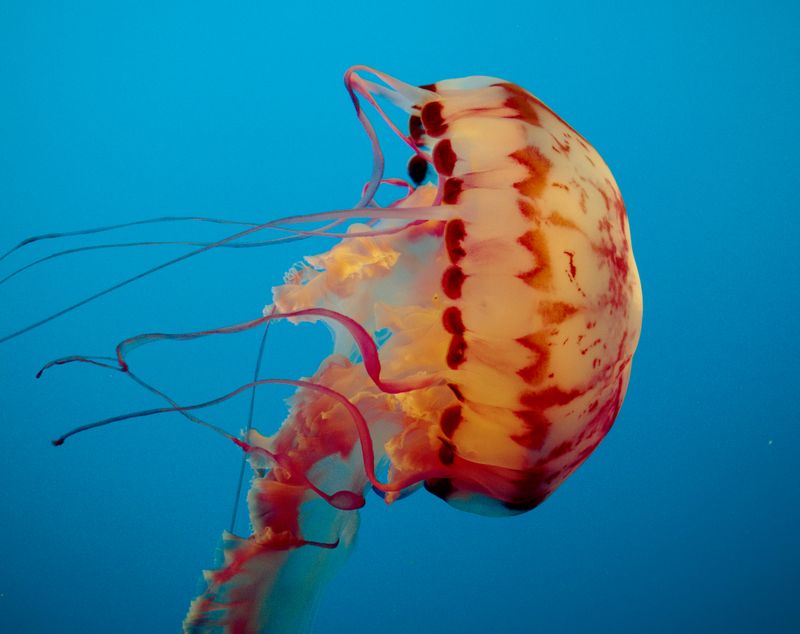
The Purple Striped Jelly, also known as Chrysaora colorata, is renowned for its striking appearance. Found primarily in the waters of Monterey Bay, California, this jellyfish is easily identifiable by the vivid purple lines that adorn its bell.
The bell can grow up to three feet in diameter, making it a prominent feature in the marine landscape. This species uses its long, slender tentacles to capture prey, including small fish and plankton.
The tentacles, which can extend several feet beyond its bell, are armed with nematocysts that deliver a mild sting to humans.
2. Barrel Jellyfish
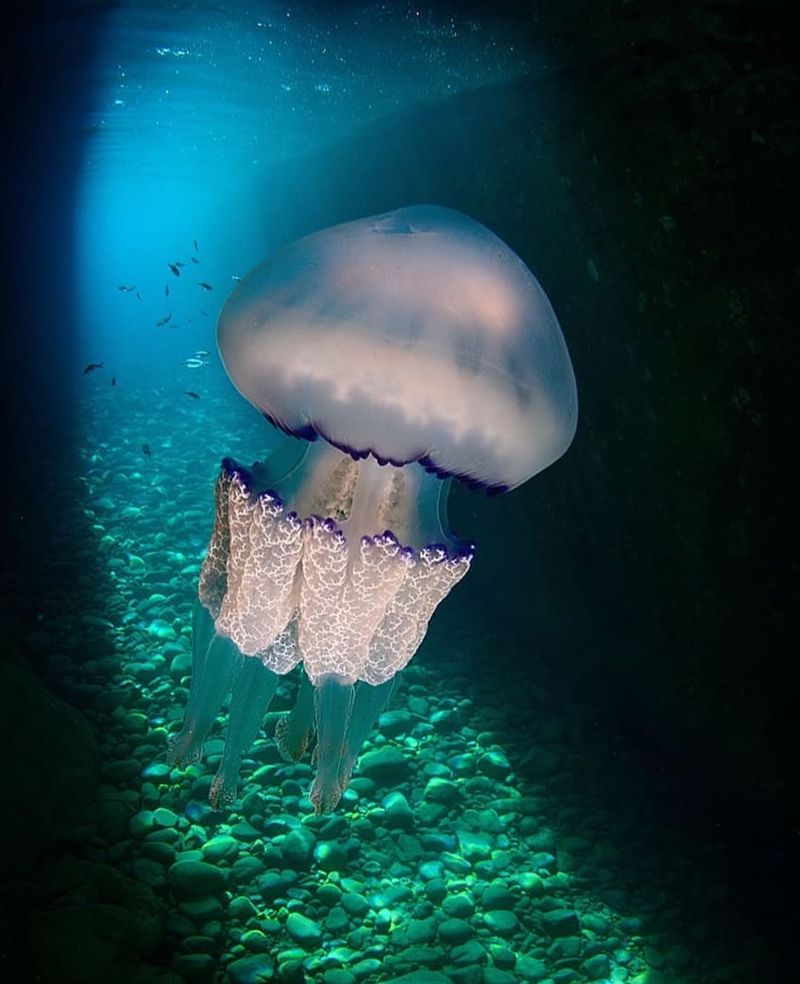
The Barrel Jellyfish (Rhizostoma pulmo) is one of the largest jellyfish species found in European waters, particularly off the coasts of the UK. With a bell diameter that can reach up to 6.5 feet, this jellyfish’s impressive size makes it an unmistakable sight.
Its body is typically translucent, with a pale blue or pinkish tint, and it features long, trailing tentacles that can extend up to 10 feet. Despite its intimidating size, the Barrel Jellyfish is known for being relatively harmless to humans, as its sting is mild.
3. Stygiomedusa Gigantea

The Stygiomedusa Gigantea, often referred to as the giant phantom jellyfish, is a rare and elusive species. It inhabits the deep ocean, often found at depths exceeding 3,300 feet. Due to its remote habitat, sightings of this jellyfish are infrequent, making it a subject of intrigue among marine biologists.
This jellyfish boasts a bell that can measure over three feet wide, with tentacles extending up to 20 feet. Its dark red coloration helps it blend into the deep ocean environment, providing it some camouflage from predators.
4. Cannonball Jellyfish
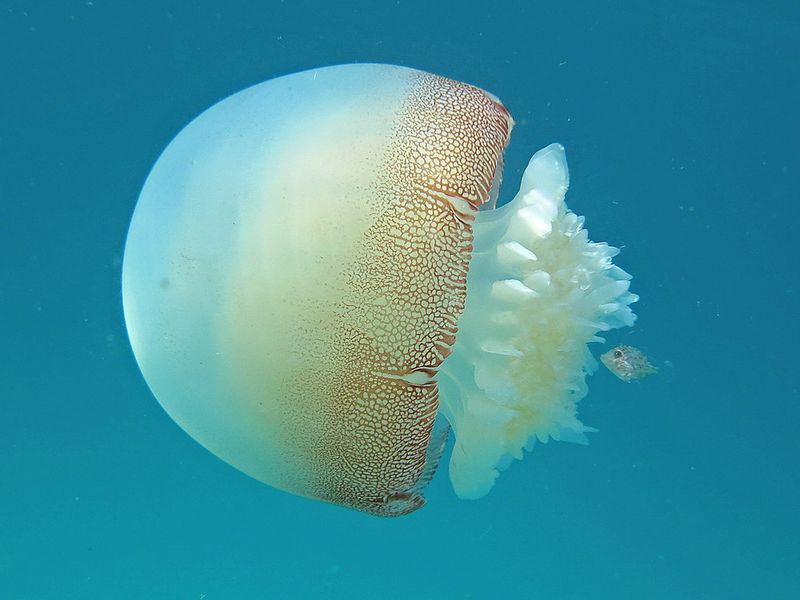
The Cannonball Jellyfish, aptly named for its spherical, cannonball-like bell, is a prevalent sight in the warm waters of the Gulf of Mexico and the southeastern coast of the United States. It is a relatively small jellyfish, with a bell diameter of up to ten inches, but it travels in large swarms, creating an impressive spectacle.
This jellyfish is characterized by its white bell with brown or reddish bands, and short, stubby tentacles. Unlike many other jellyfish, the Cannonball Jellyfish has a mild sting that poses little threat to humans, making it a more approachable member of the jellyfish family.
5. Black Sea Nettle

The Black Sea Nettle is a strikingly beautiful jellyfish that inhabits the coastal waters of the Eastern Pacific Ocean, particularly around California. It is recognized by its distinctive dark purple bell, which can grow up to three feet in diameter.
The contrast between its deep-colored bell and translucent tentacles makes it a captivating sight. This jellyfish’s tentacles can stretch over 20 feet long, equipped with stinging cells to capture prey such as small fish and zooplankton.
6. Australian Box Jellyfish

The Australian Box Jellyfish is infamous for its potent venom, considered one of the most dangerous in the marine world. Native to the coastal waters of Northern Australia, including the Great Barrier Reef, this jellyfish is a master predator despite its seemingly delicate appearance.
Its cube-shaped bell can grow up to nearly one foot in diameter, but what it lacks in size, it makes up for in lethality. The tentacles, extending up to 10 feet long, are laden with venomous cells capable of delivering a painful sting that can be fatal to humans.
7. Lion’s Mane Jellyfish

The Lion’s Mane Jellyfish is truly a spectacle in the marine world. Growing up to 120 feet long, its tentacles are longer than a blue whale. This jellyfish calls the Arctic and North Atlantic Oceans its home, thriving in the cold waters where it drifts with the currents.
Its vibrant, reddish-brown bell can grow up to eight feet in diameter. Such size makes it the largest known species of jellyfish on Earth.
Despite its intimidating appearance, the Lion’s Mane Jellyfish feeds mainly on small fish, zooplankton, and other jellyfish.
8. Sea Nettle
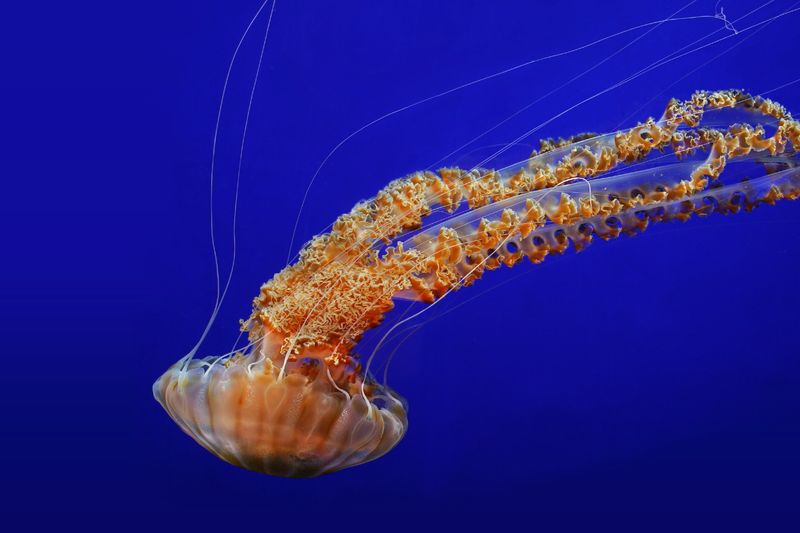
The Sea Nettle is a common yet captivating jellyfish found along the Atlantic coast of the United States, particularly in the Chesapeake Bay. It is known for its golden-brown bell, which can reach sizes of up to one foot in diameter.
The long, graceful tentacles trailing behind can extend several feet, equipped to capture a variety of prey. Though its sting is mild, it can cause discomfort to swimmers, making it a frequent encounter during beach outings.
9. Barrel Jellyfish

The Barrel Jellyfish is a gentle giant of the ocean, commonly found in the coastal waters of the United Kingdom. Its massive, translucent bell can grow up to 3.3 feet in diameter, making it one of the largest jellyfish in European waters.
Despite its size, it is harmless to humans, with a sting that is considered mild and typically non-threatening. This jellyfish feeds on plankton, using its multitude of tentacles to capture its tiny prey.
During the warmer months, the Barrel Jellyfish often washes up on beaches, creating a stunning sight for beachgoers. Its presence is a natural phenomenon, reflecting changes in ocean conditions and currents.
10. Nomura’s Jellyfish

Nomura’s Jellyfish is another marine giant, primarily found in the waters of the Sea of Japan. With a bell diameter that can reach up to 6.6 feet and a weight of over 440 pounds, it is one of the largest jellyfish species known to humankind.
Its sheer size can be both awe-inspiring and intimidating, especially when encountered by fishermen. This jellyfish is characterized by its translucent, pinkish-brown bell and long, frilled tentacles that can extend several feet.
11. Japanese Sea Nettle
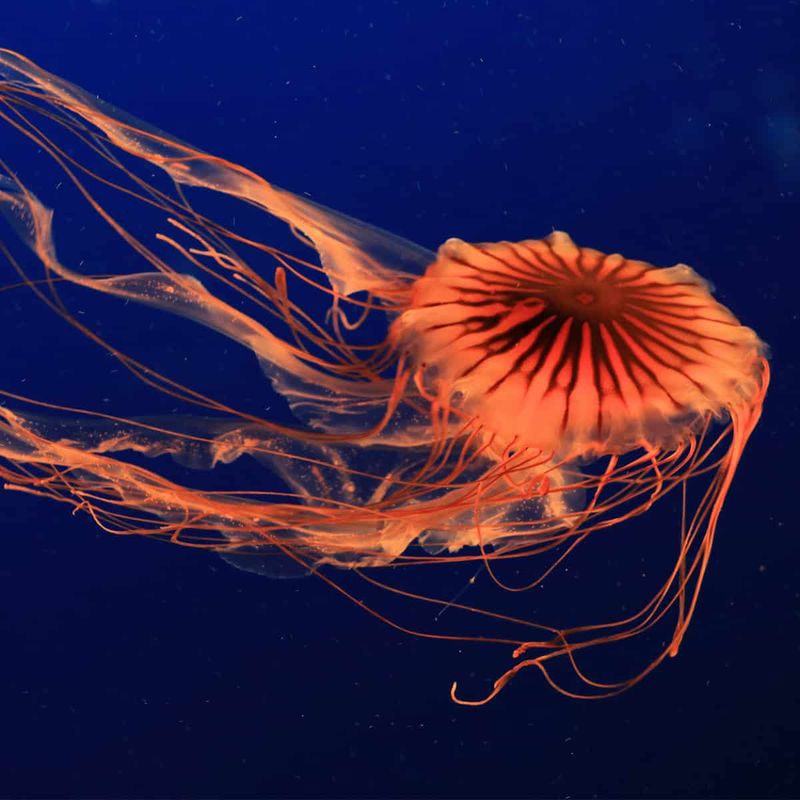
The Japanese Sea Nettle is a vibrant and captivating jellyfish found in the waters of the Pacific Ocean, particularly around Japan. Its striking orange bell, which can grow up to two feet in diameter, contrasts beautifully with its long, flowing white tentacles.
This color combination makes it one of the most visually stunning jellyfish species. This jellyfish uses its lengthy tentacles to capture prey such as small fish and zooplankton.
Although its sting is mild to humans, it is effective in immobilizing its prey. The Japanese Sea Nettle is often seen in large groups, creating a mesmerizing underwater display.
12. Pacific Sea Nettle
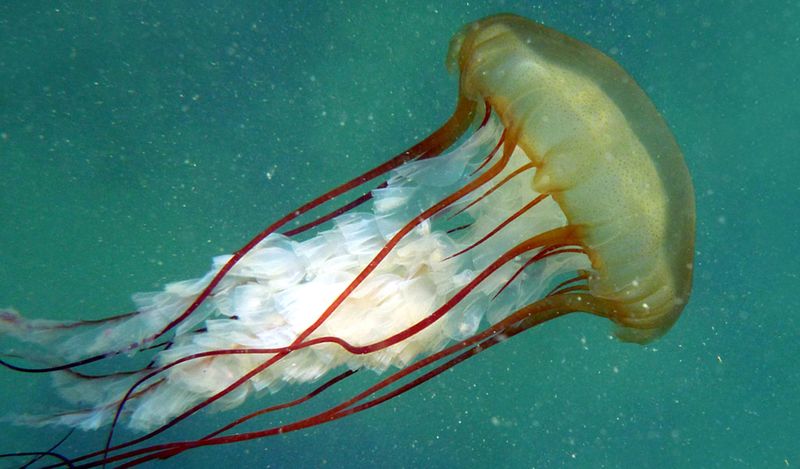
The Pacific Sea Nettle is a stunning jellyfish species that graces the waters of the North Pacific Ocean. Its golden-brown bell, which can grow up to two feet in diameter, is complemented by long, spiraling tentacles that extend several feet.
This jellyfish is both a predator and a prey, playing a crucial role in the marine food web. The tentacles of the Pacific Sea Nettle are armed with stinging cells that capture prey such as small fish and plankton. While its sting can be uncomfortable for humans, it is not considered dangerous.
This jellyfish is often found in large swarms, creating a breathtaking sight for divers and ocean enthusiasts.
13. Moon Jellyfish
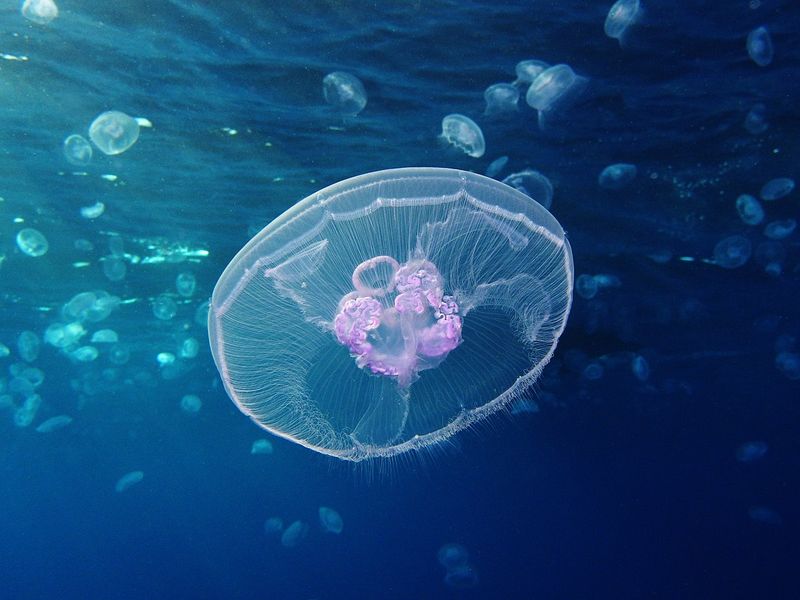
The Moon Jellyfish is an enchanting and widespread jellyfish species, known for its gentle, moon-like appearance. Its translucent bell, which can grow up to 15 inches in diameter, is easily recognizable, featuring four distinct horseshoe-shaped gonads at its center.
This jellyfish is commonly found in shallow coastal waters around the world. Despite its delicate look, the Moon Jellyfish is a resilient species, capable of adapting to various environmental conditions.
Its diet consists mainly of small fish and plankton, which it captures using its short, fine tentacles. Although its sting is harmless to humans, it is effective in securing its prey.
14. Tiburonia granrojo
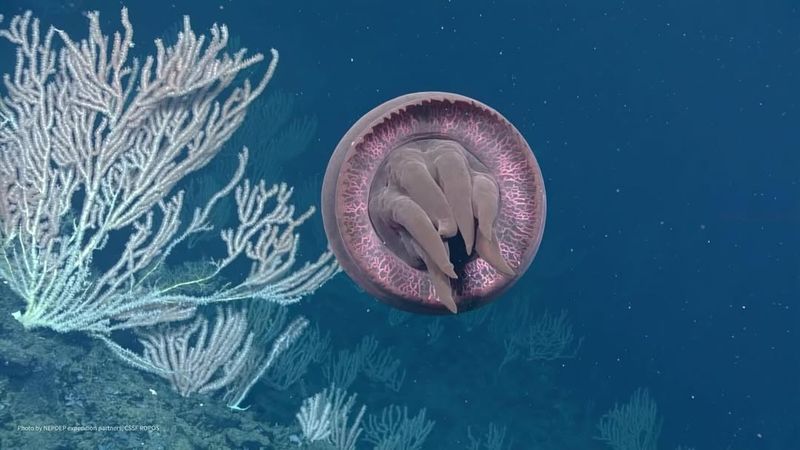
Meet the Tiburonia granrojo, a massive jellyfish distinguished by its vivid crimson hue. Found in the dark depths of the Pacific Ocean, this jellyfish grows up to an impressive three feet in diameter. Its striking color and formidable size set it apart from most of its oceanic kin.
This jellyfish’s bell is adorned with thick, frilly oral arms instead of tentacles, creating a unique and mesmerizing sight as it drifts through the water. Its presence in the deep sea is both captivating and mysterious, drawing the curious into its world.






